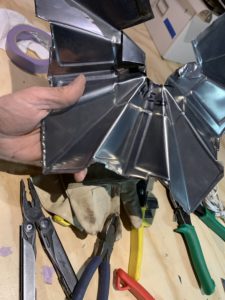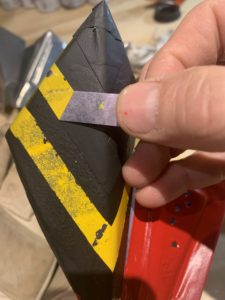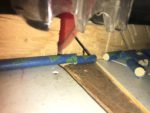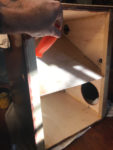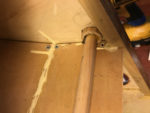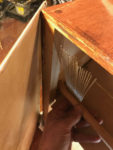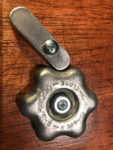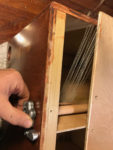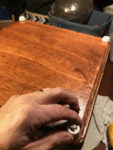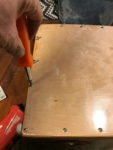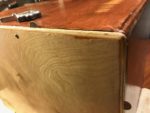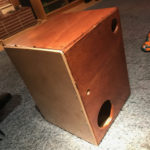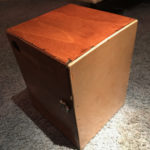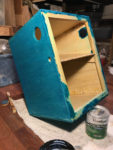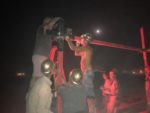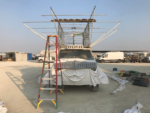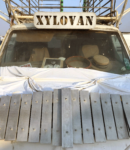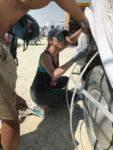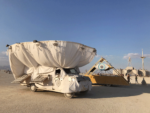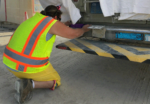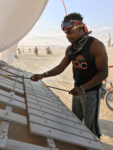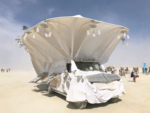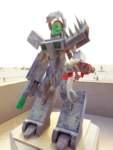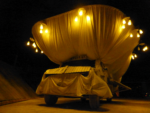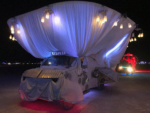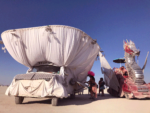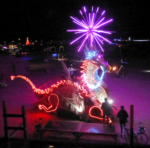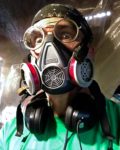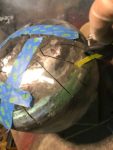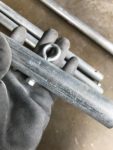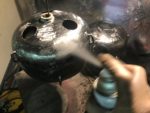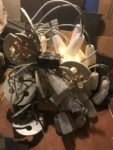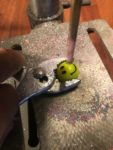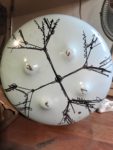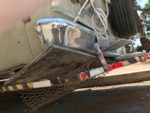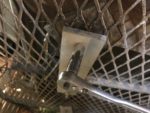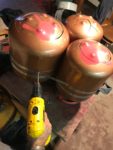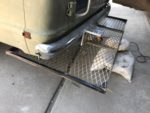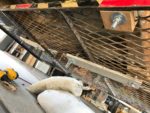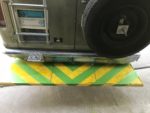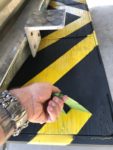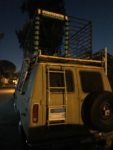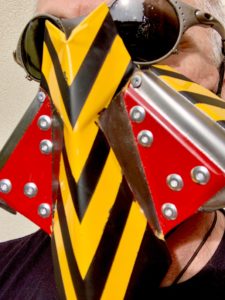 I learned some things on the first mask. I’m still really pleased with the way it turned out, but this time around I primered the surfaces I intended to paint, and the paint went on a lot more smoothly and did not crawl and craze in the way that gave the first mask it’s beaten-to-hell patina.
I learned some things on the first mask. I’m still really pleased with the way it turned out, but this time around I primered the surfaces I intended to paint, and the paint went on a lot more smoothly and did not crawl and craze in the way that gave the first mask it’s beaten-to-hell patina.
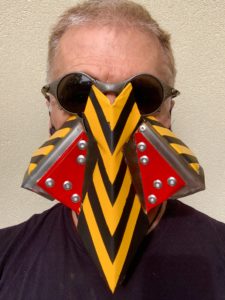
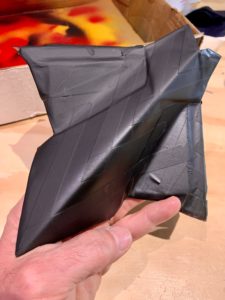
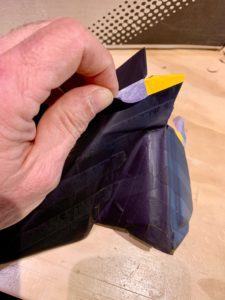
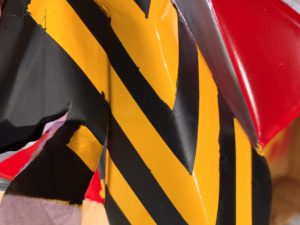 IMG_2106
IMG_2106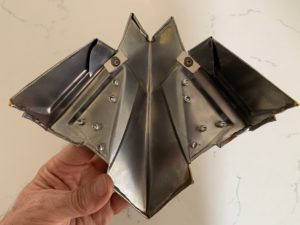
Quarantine project – pandemic masks
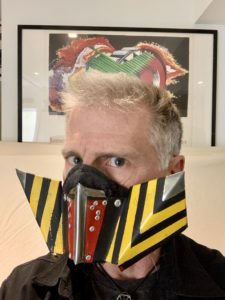 I’ve started a new personal project about the pandemic, masks and fear.
I’ve started a new personal project about the pandemic, masks and fear.
I’ve had these sheets of tin ceiling floating around the shop unused for years and found that the stuff lends itself to cutting, bending, painting and rivets, plus it’s sturdy and not too heavy to wear. (And yes, that’s a double-layered cloth mask behind the tin, so it’s wearable in public as protection.) You can find more in-process shots on my IG.
Others are in the works. Watch this space!
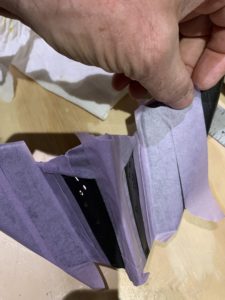
R.I.P. XyloVan – 2010-2019
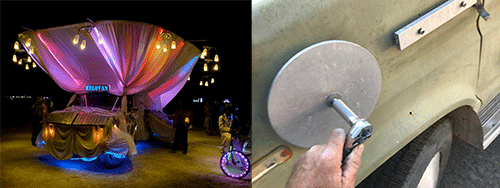
XyloVan began its life nearly 10 years ago as an idea: Let’s build a mutant vehicle so our young kids can ride around even after bedtime and we can all enjoy Burning Man safely together after dark.
The van’s full, rich and musical life ended last month – after so many adventures, mishaps and miracles that I never could have dreamed of – with me stripping off the xylophones and gongs and putting the vehicle up for sale.
It was like building it all over again – but in reverse. (see photos below after the jump)
Deeply bittersweet.
I peeled off the magic, wrenching the hand-made instruments from the 3/8-inch mounting bolts where they had ridden ever since 2010, when my wife and kids and I began transforming a 1985 Ford 350 ClubWagon XLT into the only musically-playable art car I’ve ever met.
I unwired the control pod carrying the digital-delay mixer and Arduino control box, and stowed the electronics and cables for future projects. I put the instruments into long-term storage against the day when I might bee foolish enough to build another musical mutant vehicle. And I turned the van over to … Continue reading R.I.P. XyloVan – 2010-2019
XyloVan is (mostly) FOR SALE
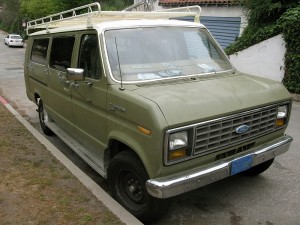 You read that right: This day had to come. We’re moving, and the time has arrived for me to send XyloVan (1) on to its next incarnation.Â
You read that right: This day had to come. We’re moving, and the time has arrived for me to send XyloVan (1) on to its next incarnation.Â
Underneath the instruments, (and the patina of wonderful music, noise and love that thousands of people have laid on them during its 9.5-year existence), lies a sturdy old 1985 Ford ClubWagon XLT. It is dying to be reincarnated as a new mutant vehicle – maybe yours.
I’m moving soon to a place where I won’t be able to park its 25-foot length, and I’ve been thinking of changing XyloVan’s basic design for quite some time now.
So, it’s time to split the music from the van, and send both on to new lives.
I will mount the instruments on a new vehicle (design still in the works). And I am selling XyloVan’s base vehicle WITHOUT INSTRUMENTS –  asking price $350. Â
Somewhere out there, a fellow Burner with dirt under his fingernails and fire in his eyes needs this van – and can envision a new mutant vehicle built on this beefy, high-capacity foundation. Any questions?
Here’s what you get:
Â
1985 Ford ClubWagon XLT
- 7.5-L V8 engine, RUNS STRONG
- Interior seating for 10, or
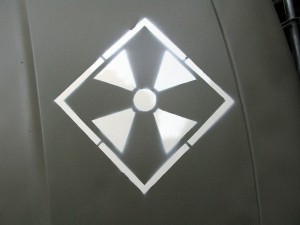 aninsane amount of cargo room if you pull the benches.
aninsane amount of cargo room if you pull the benches. - Standing room on the roof (with a ladder and attachable chest-high guardrails!) for 10-12 people
- Full-width rear step for easy loading of people & gear
- Rebuilt V8 cylinder heads
- Rebuilt carburetor
- Rebuilt steering box and front end
- New water pump
- New alternator and voltage regulator
- Near-new tires
- Stereo/CD player with MP3 jack
- Onboard 12V power system with two deep-cycle marine batteries
- 12V Arduino panel with 12 RGB/LED light circuitsÂ
- 120V AC power inverter
- Extra Flair: Burning Man Department of Mutant Vehicle daytime and nighttime permit stickers and playa vehicle passes for 2011, 2014 and 2018.
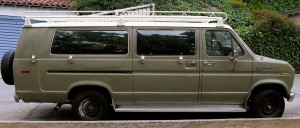
Full disclosures:
- Xylophones and gongs are NOT INCLUDED
- No AC.Â
- Some oil leaks.
- Bodywork will have some holes left by removal of the mounted instruments.Â
- There is no body rust of any size, but the paint is heavily weathered
- Must be jump-started at the moment, as it has a (probably simple) charging problem I’m not qualified to solve.Â
Other than that, it’s a rock with a ton of history and dust in it. It will definitely make thousands of passengers (and a few mutant vehicle builders with fire in their eyes) very, very, very happy.
Want to come by and take a look? Ping me!
Veering off into left field – to build a marimbula
This is a long way from xylophones and propane-tank drums, but I’ve really enjoyed building cajóns and – for the first time – a marimbula.
The marimbula is a Caribbean instrument, descended from the African kalimba, and generally functions as a bass. As you’ll see in the video at the bottom of the post, I first experimented with a 6-key marimbula built onto the back of one of my cajons, just to figure out the basics of construction.
This one is a 16-key marimbula – which I’ve decided has about three too many bottom-end keys and perhaps one too many high-end keys, as the sound quality falls off quite a bit at the ends of its scale. Next, I might try building one like a piano keyboard (with two layers of keys in white and black) centered in the middle of this scale.
The tuning has been kinda challenging – I finally settled on D – but I’m tuning it slowly by ear because the digital tuning apps can’t handle all the overtones it puts out. Anyway, it’s a helluva lot of fun to play – particularly on a nice, resonant wood floor – because it’s easy to play, and the notes send vibrations through your butt and up your spine. I take great satisfaction in building instruments that create physical joy along with pleasant music.
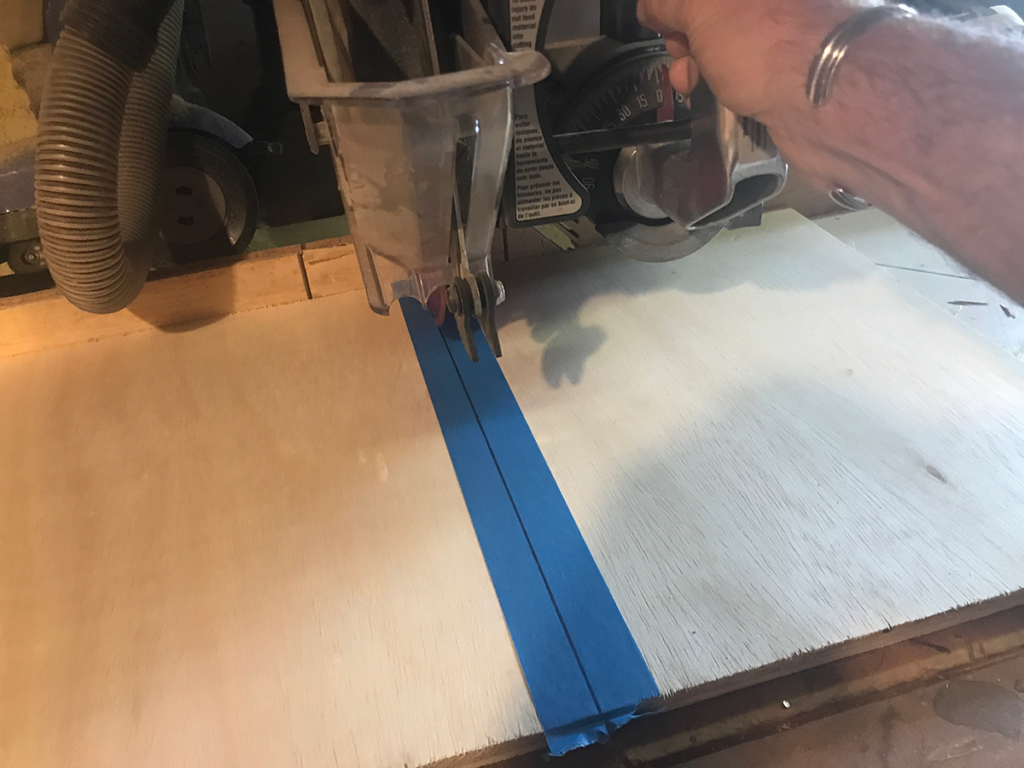
I use white birch finish plywood. I cut the box pieces through masking tape, which makes for clean cuts by keeping the blade from shattering the delicate veneer. 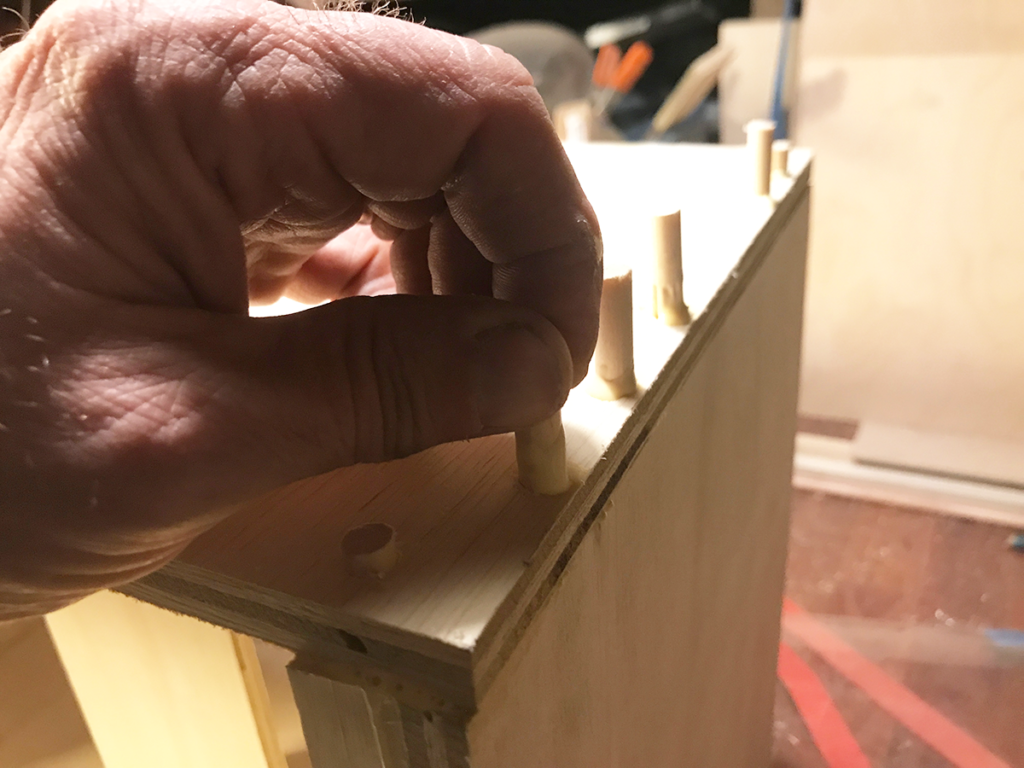
Dry-fit the pieces, then drill for pegs. I cut my own from 5/16″ dowels, which makes for cleaner joins than you get with factory-made pegs. 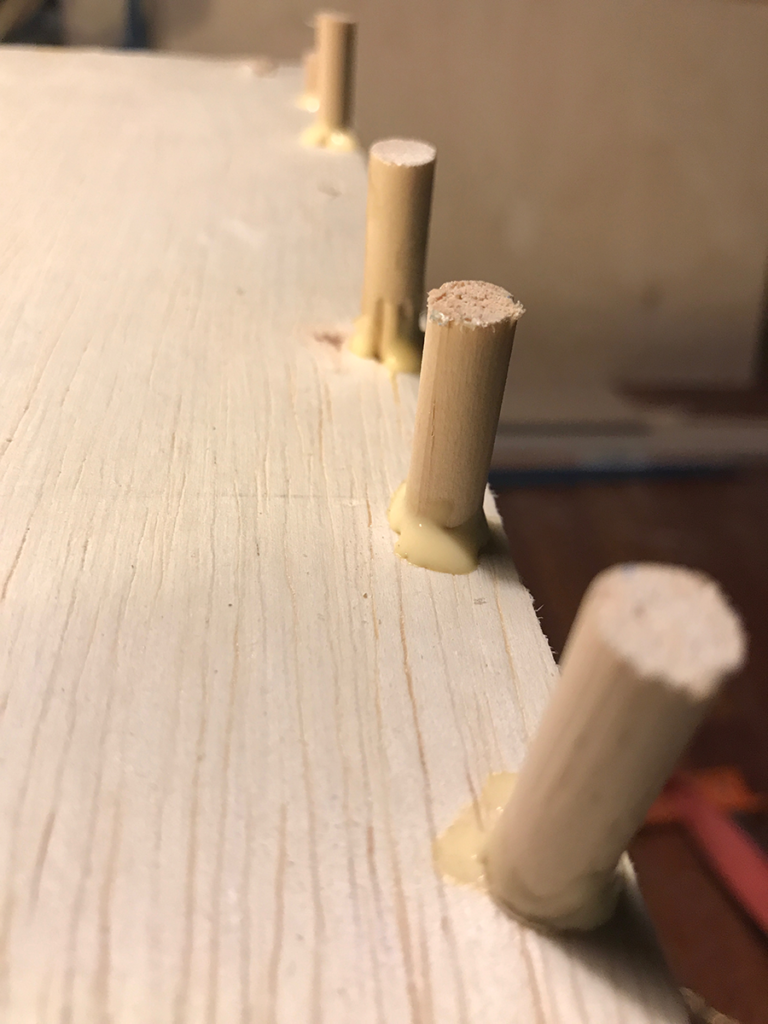
Glue all the plywood points, then add some glue to the peg holes … 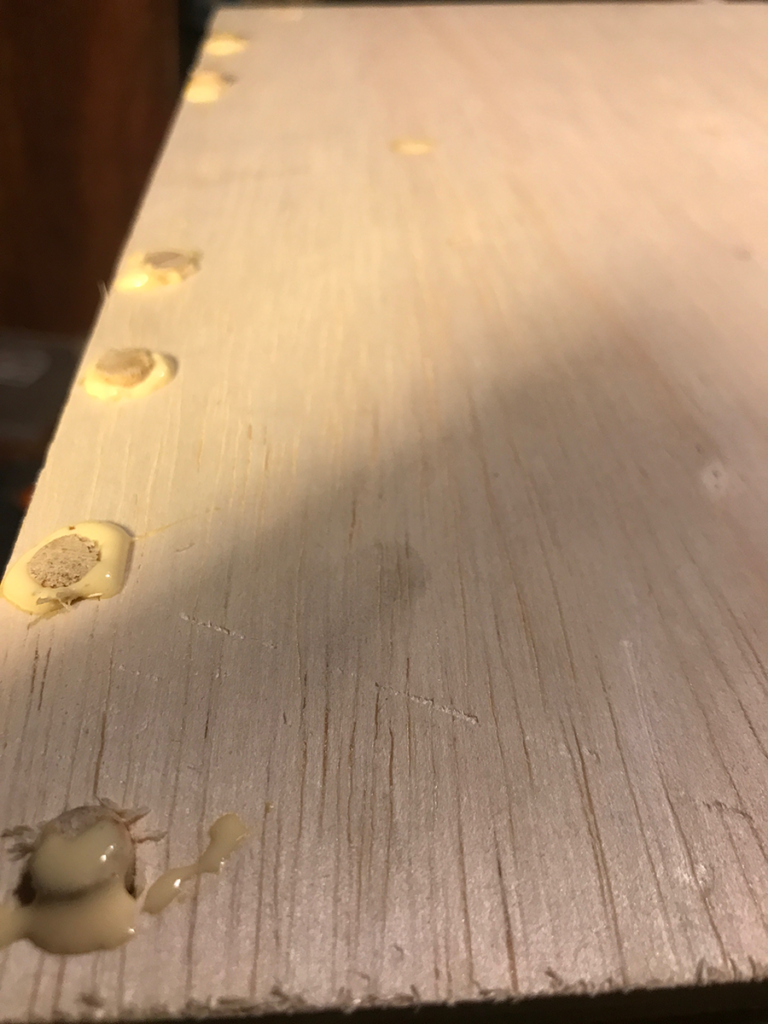
… and drive them all in. I’ll sand off the excess to make them flush with the surface when everything is dried. 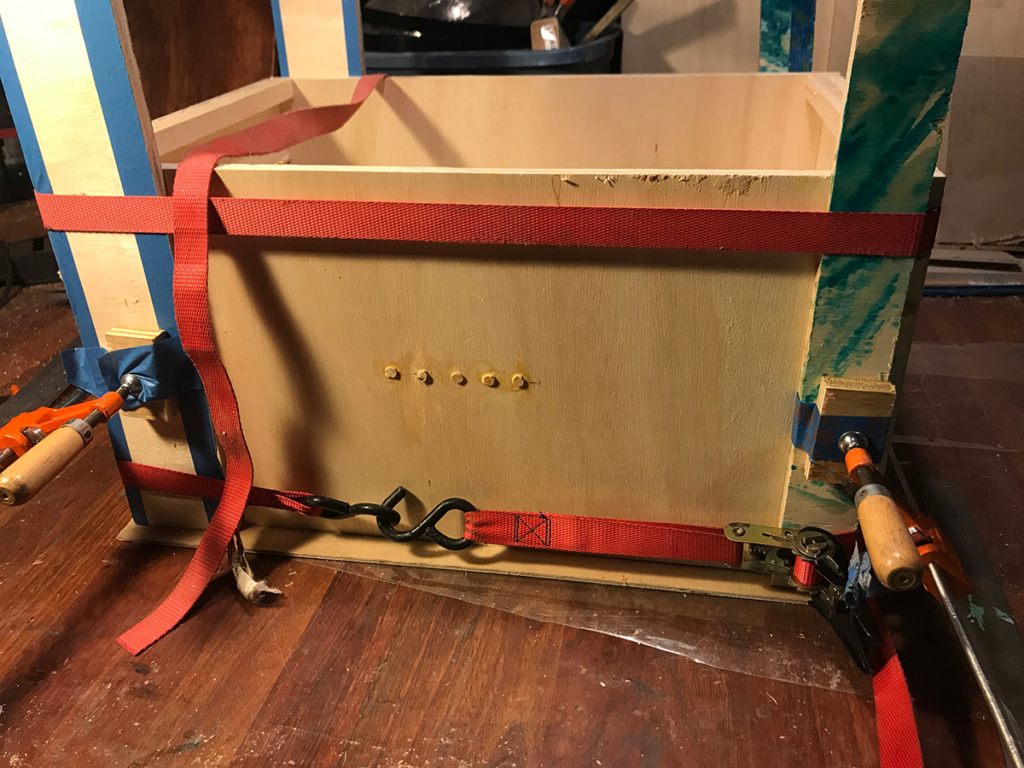
Being short on (pricey) carpenter’s bar clamps, I use the two I have, then augment with ratchet straps. The vertical chunks of scrap plywood keep the straps from damaging the veneer. 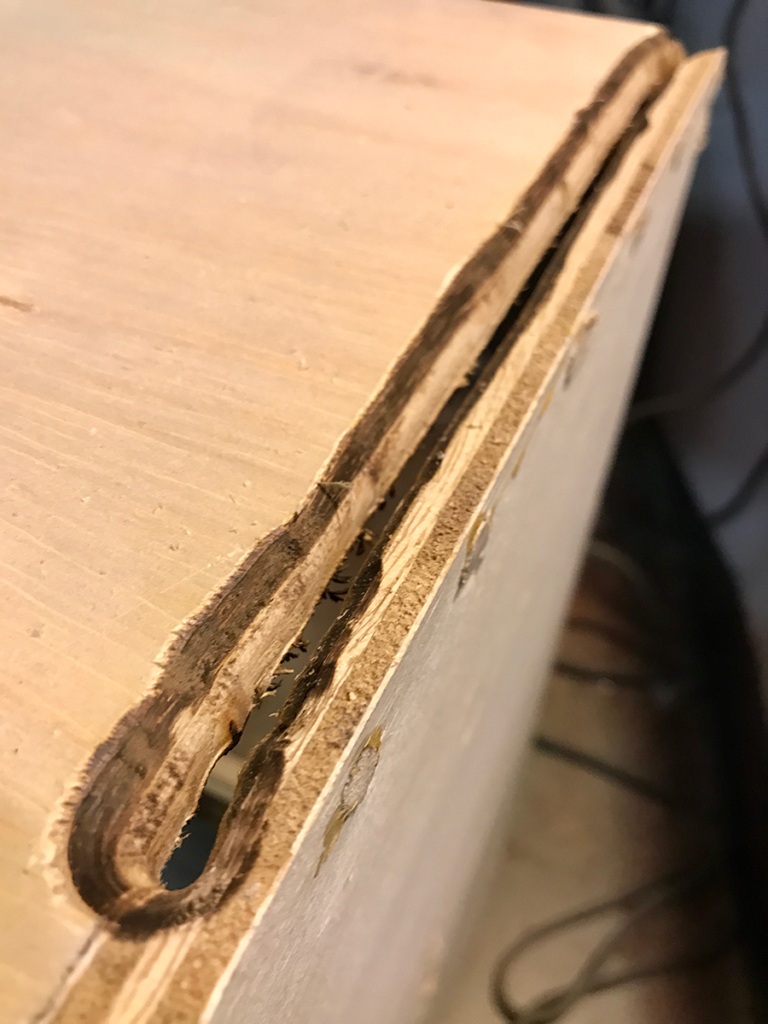
This is deeply embarrassing as well as horrible-looking: I failed t set up the router correctly, then dragged it straight through the face of the box instead of nicely rounding the corners. After much cursing and shouting, I just capped the whole gashed end with another layer of plywood. 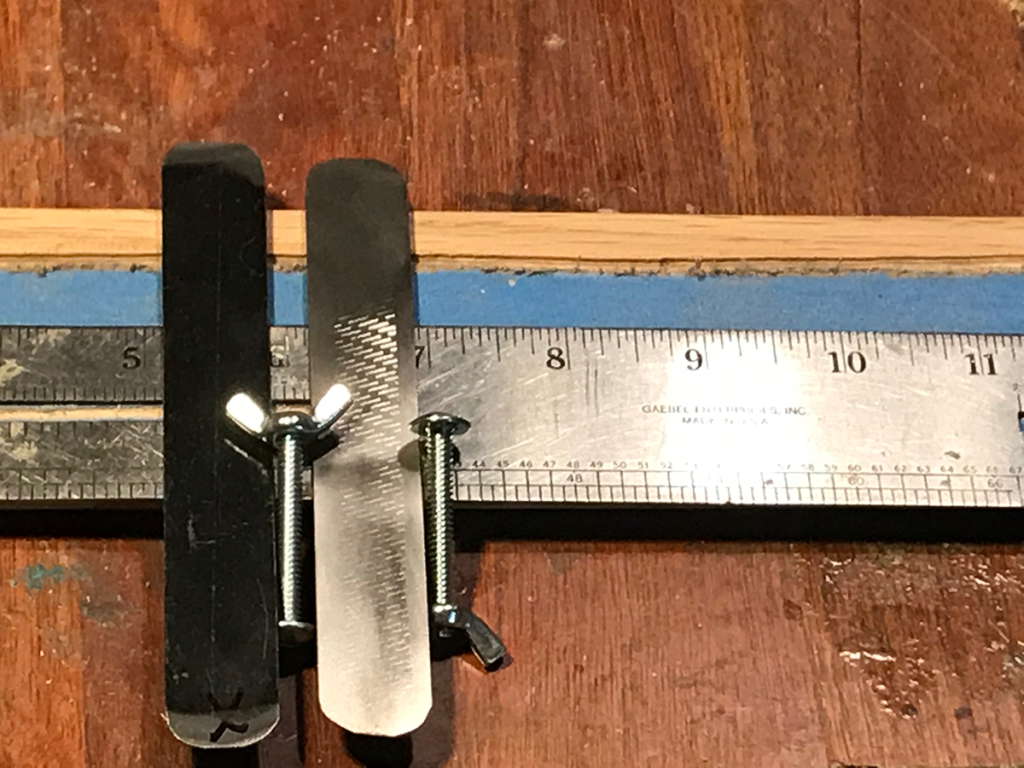
Laying out the keys and the bridge pegs, and trying to decide whether to use the black anodized finish found on these scraps of spring-steel shipping strap, or polish it and use the moiré pattern left by the tools. 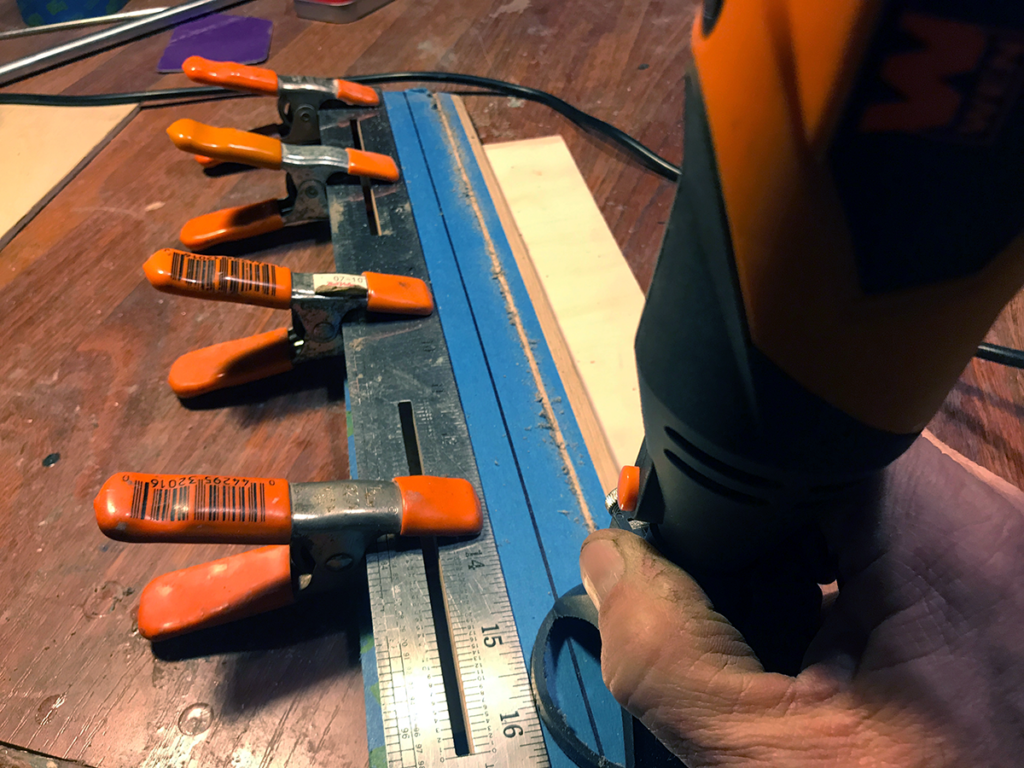
The bridge is a strip of red oak. I clamped a ruler to it to guide the router, which I used to cut a groove for the bridge’s nut bars (terminology?) to sit in. 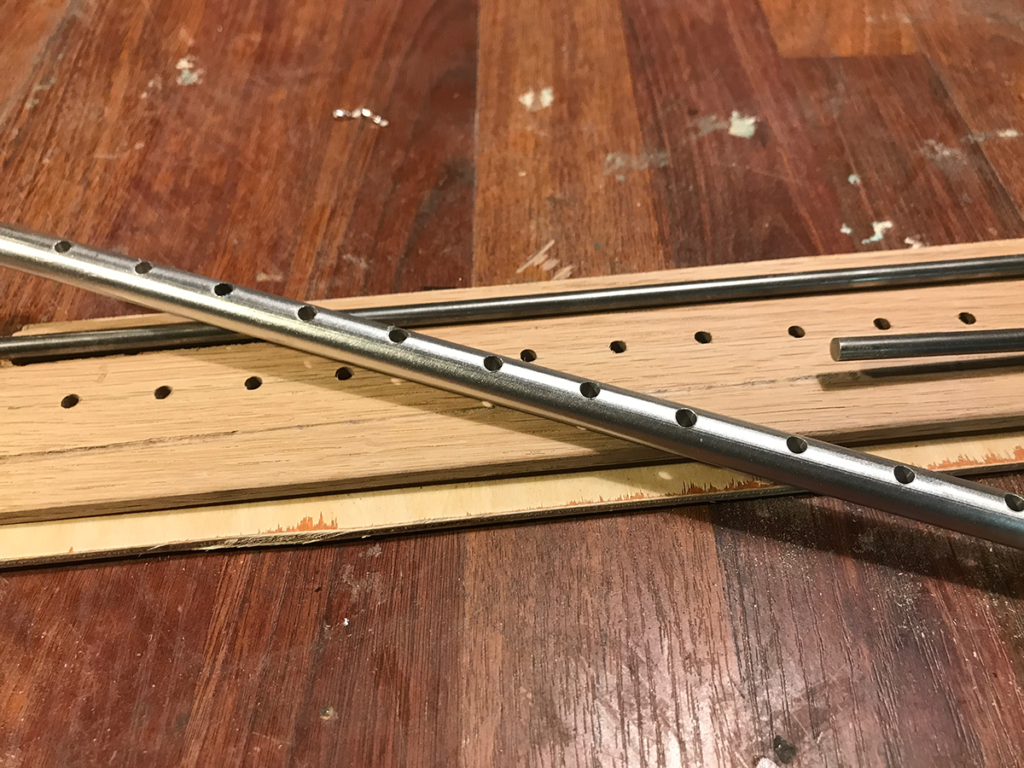
The completed bridge pieces – red oak, stainless-steel nut bars (which the keys will rest on) and a carefully-drilled-out rod of aluminum for the bridge, which will clamp the keys down to the nut bars. 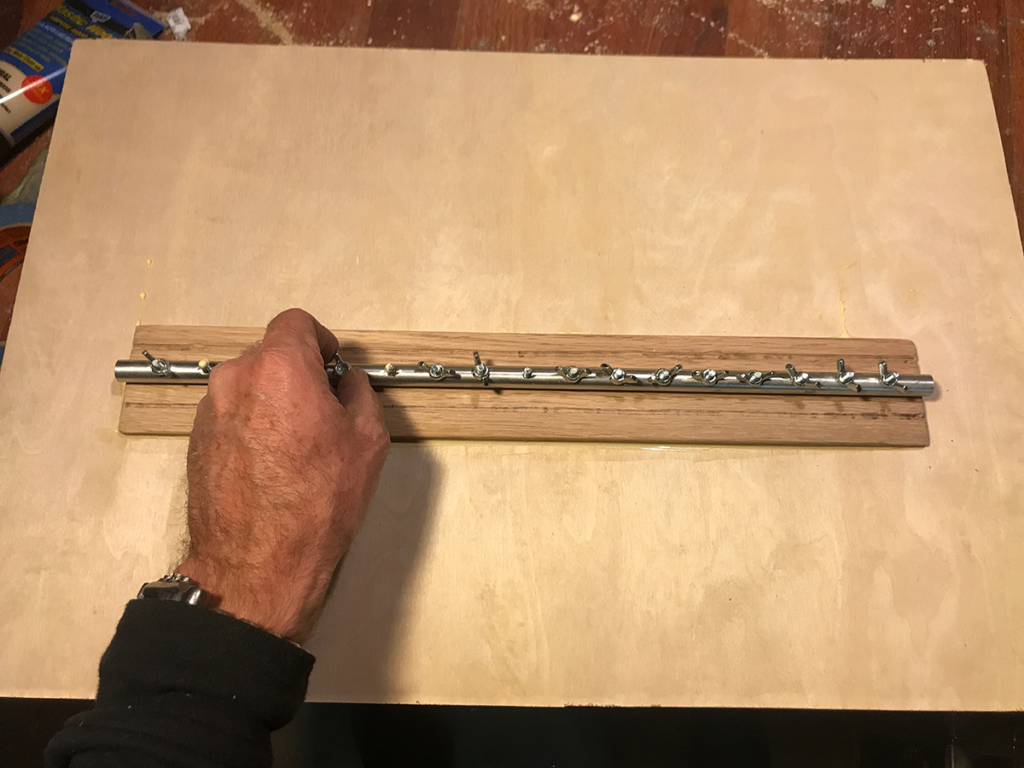
I cut a piece of 1/8-inch birch ply for the face, then drilled it out and mounted the bridge assembly (traditionally called the harp) to it with machine screws and wing nuts. 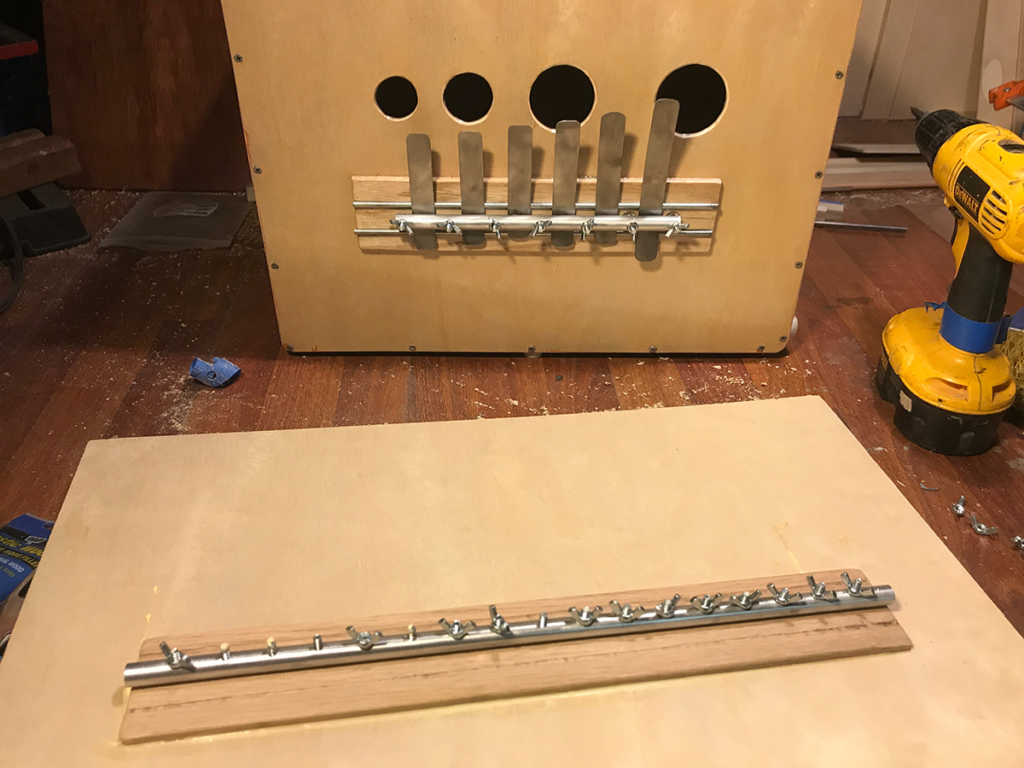
Here’s a comparison of the 16-note bridge with the 6-note bridge I mounted on the cajon that I used as a test mule. 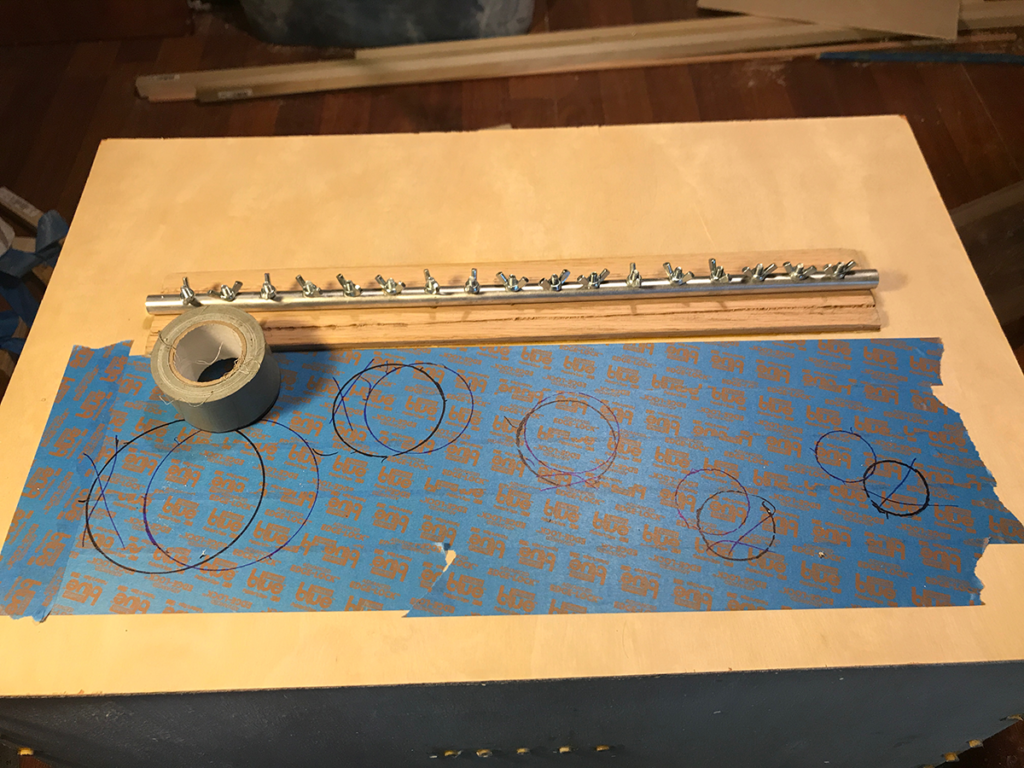
After masking the face to prevent splintering, I laid out the sound holes, then cut them with a keyhole saw (for the smaller ones) and a roto-zip bit on my knockoff Dremel for the two largest ones. 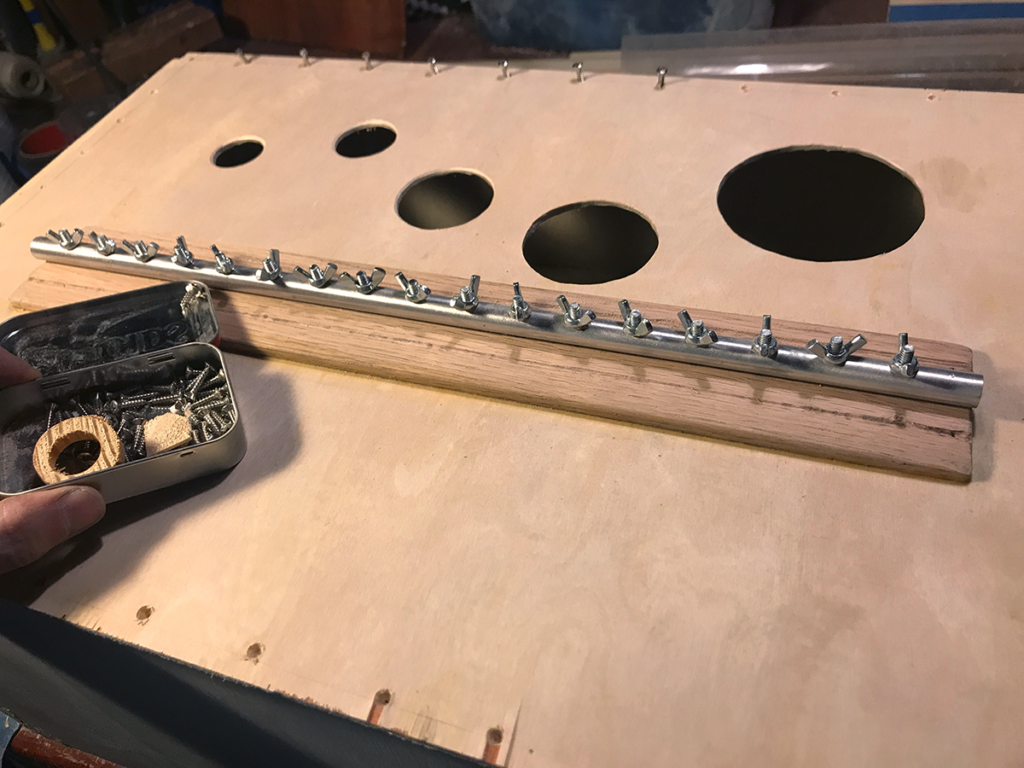
Next, I drilled all the holes for the screws – way too many, it occurred to me way too late, but the large number of screws actually wound up helping the overall visual design. 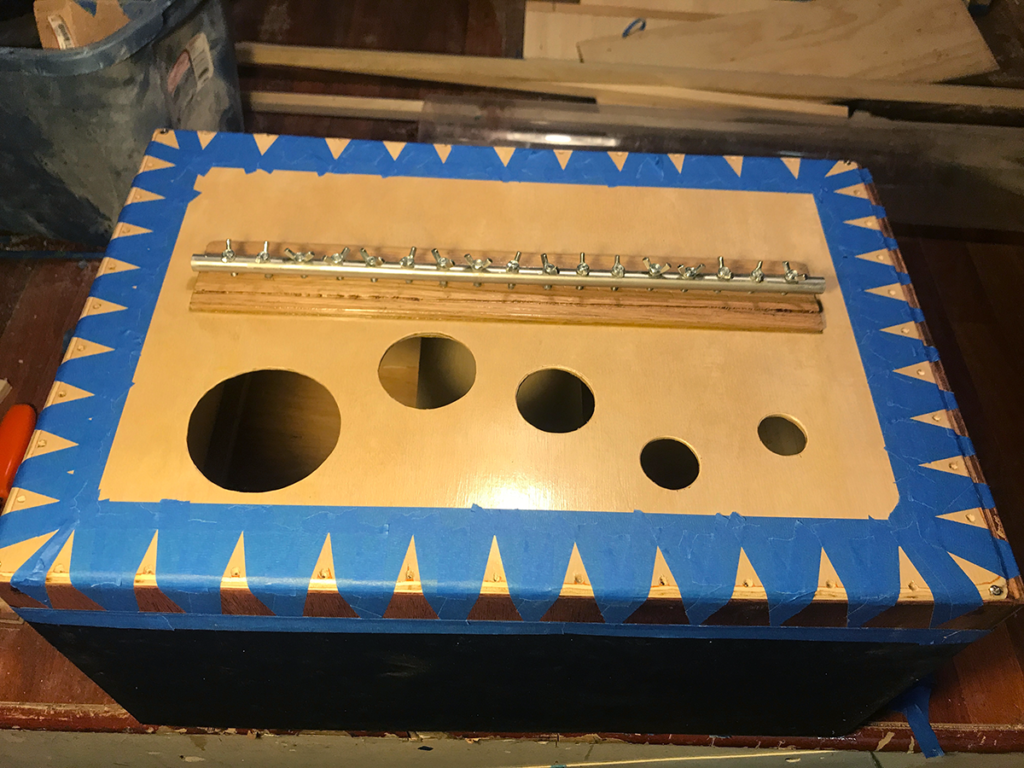
I masked off the edge for painting. 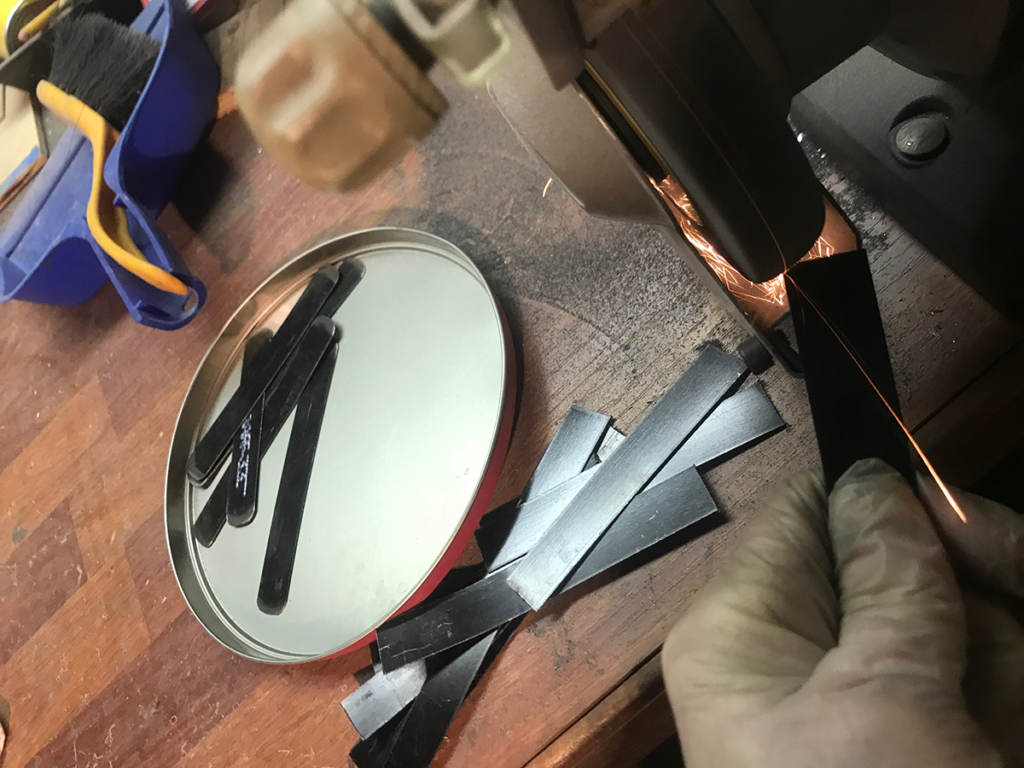
Earlier, I cut the shipping strap chunks into rough lengths with an angle-grinder, then ground the corners round … 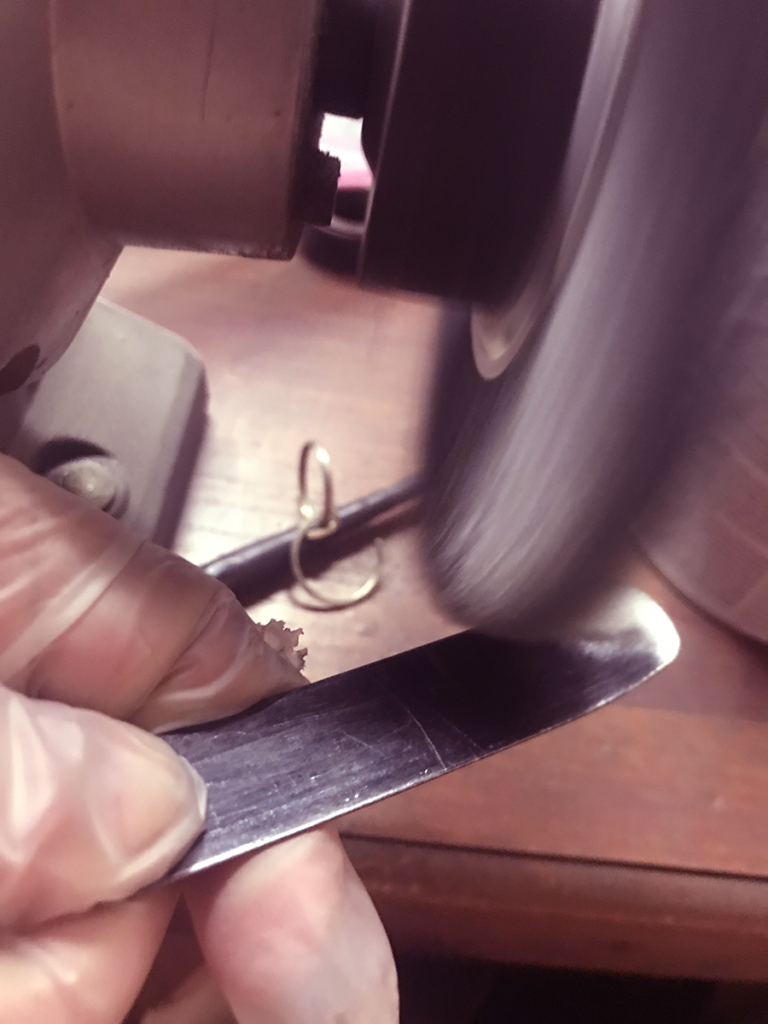
and smoothed them with a wire wheel. 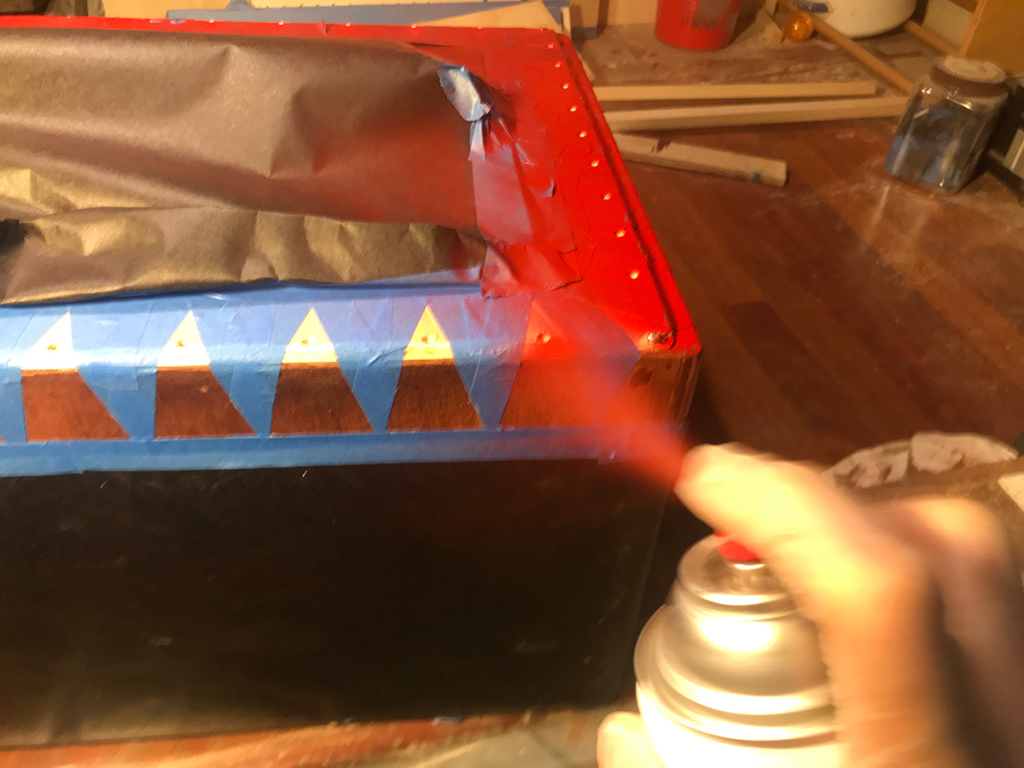
Shot the masked instrument body with red enamel (a favorite) 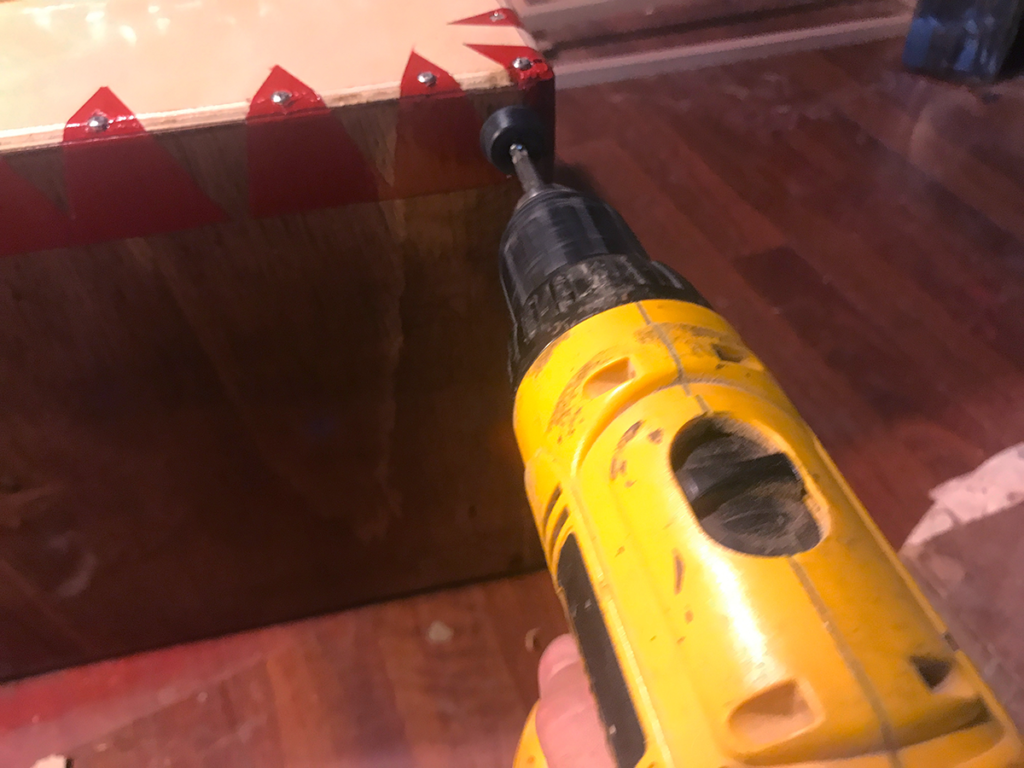
… and screwed on some little rubber feet to protect both the floor and the wood, since you’re meant to sit on the instrument to play it. 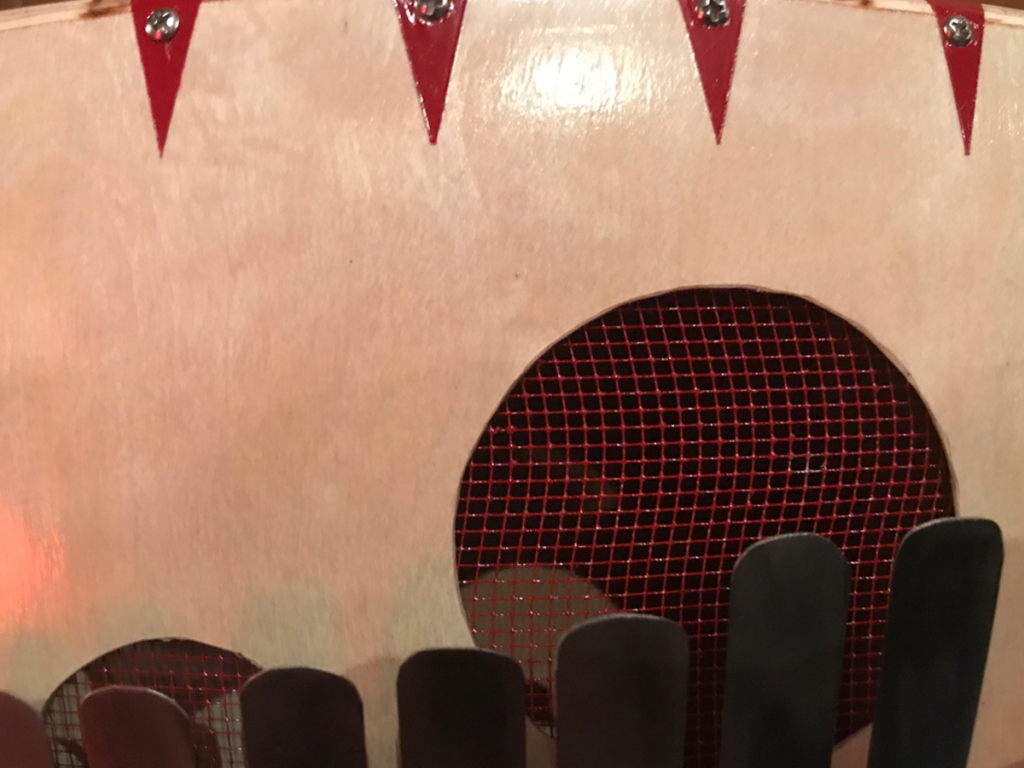
To add a little bit of drama (and filter out toys, crayons and Cheerios that younger musicians might be tempted to insert in the sound holes, I spray painted some metal fabric and glued it to the backside of the face with Liquid Nails so it wouldn’t buzz when the instrument is played. 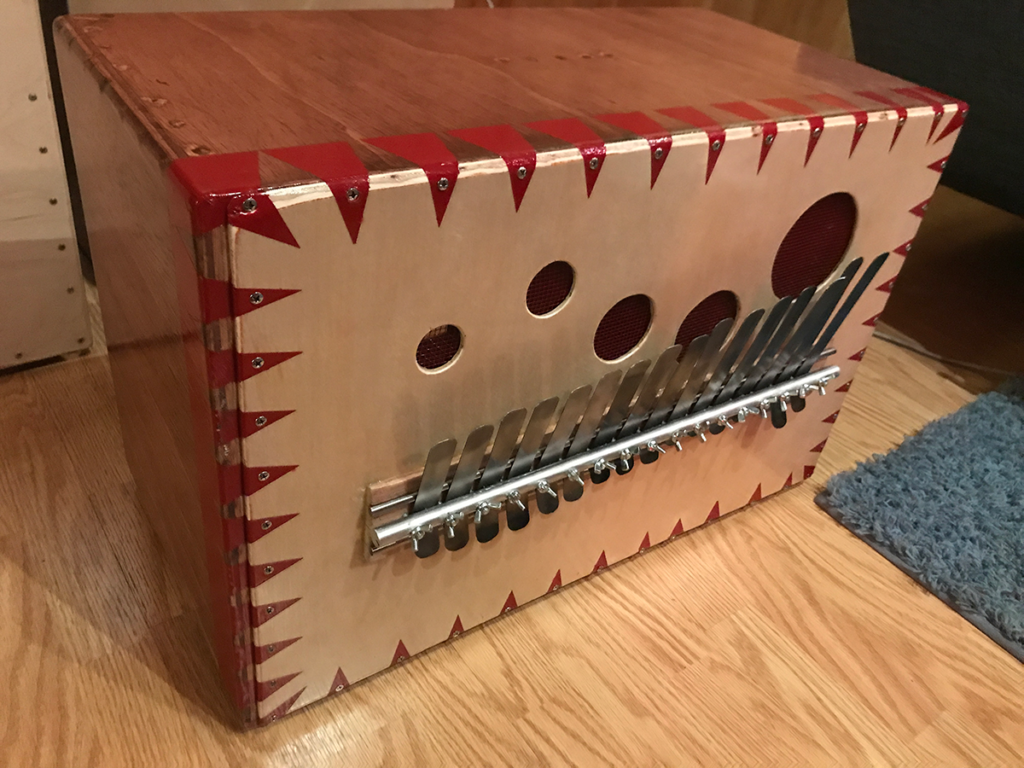
Et voila. 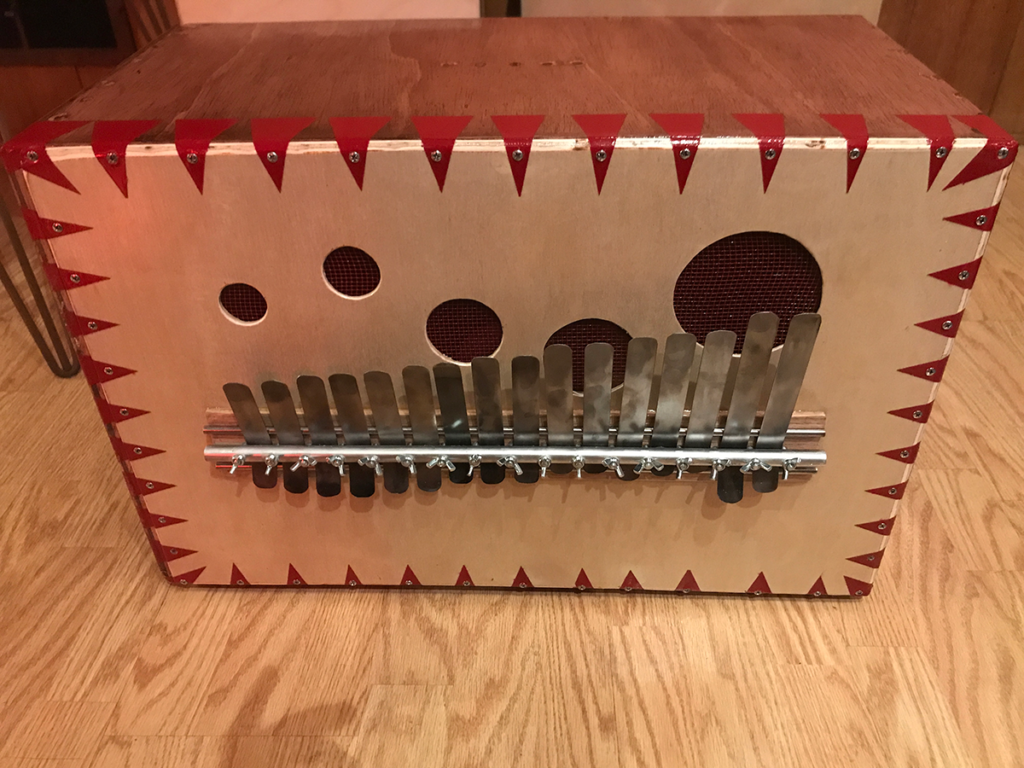
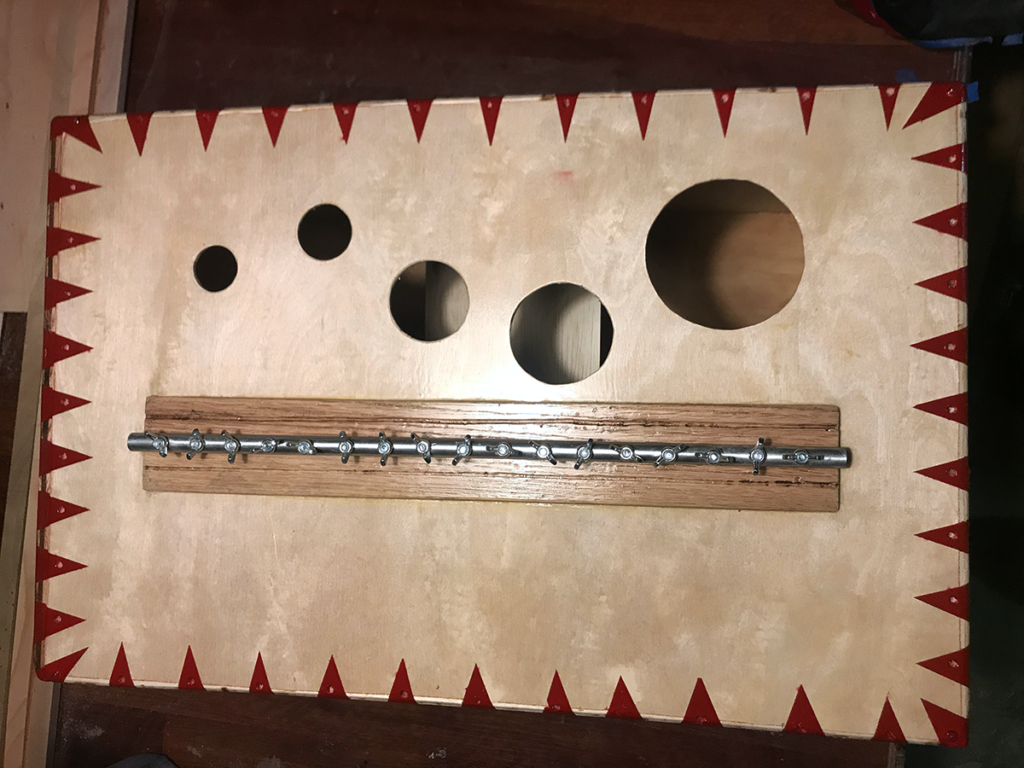
Building cajóns – all of a sudden
The old-timey title for this post could have been:
The Wisdom and Benefits of Contemplating a Temporary Shift from the Traditional Norm for This Institution in Materials, Methods, Design and Construction of Multi-Purpose Acoustic Percussion Instruments:
Or, a “Box to Bang On”
Because this post is about a kick in the head. A total world-shifting creative non-sequitur from all this demanding, burly, unforgiving metal I’ve been working with for so many years.
All of a sudden I’m building cajóns. Out of wood. Where did *that* come from.
Lemme back up a bit.
I’ve been goofing around with the idea of combining disc gongs with a sound box like the one I built a million years ago for my very first xylophone.
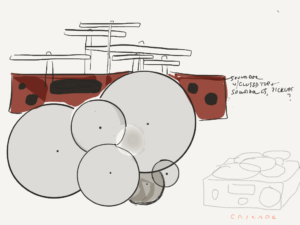 I wanted to explore: disc arrays, resonance, materials, instrument playability.Here’s a sketch: —->
I wanted to explore: disc arrays, resonance, materials, instrument playability.Here’s a sketch: —->
And then it occurred to me that the cajón (a sit-upon box drum with  roots in Peru and on loading docks everywhere) is such a perfect blend of structural integrity and resonance – like musical furniture – that if I could build one strong enough, it could do double duty as both metallophone and drum.
Gee, that sounds like a lot of work.
Maybe just start with building a good cajon to see if it’s easy enough. So, after digesting half a dozen how-to’s on YouTube and stealing some of the most interesting design ideas into my plan, I started my first.
Here’s a ragged build log:
Photos, videos and thoughts from Burning Man 2018 – The Big WHY
It’s been four years since I first mutated XyloVan as “the Light Fandango” and cruised the playa dressed as a glowing ballroom ceiling.
This year’s journey to Burning Man proved just as magical as the 2014 outing, thanks to amazing new campmates at OKNOTOK who helped me build and light it, a couple of excellent percussion cruises, and an endless stream of beautiful people who came to play the instruments.
More thoughts – and a question for you – below the images and videos:
Random notes from the keyboards.
Brief clip of art cars in line for night inspection at the Black Rock City Department of Mutant Vehicles.
The gorgeous RadiaLumia.
People question Burning Man – as they should.
Why bring millions of dollars of art, energy and resources into a godforsaken desert, run around like maniacs, burn a lot of it to the ground and then go home?
Why not put all that power and cash into solving problems, feeding the hungry, educating the young, improving humanity?
What the hell is all this for?
I think that, at some deep, cellular level, humanity needs to Burn. The immediate purposes – entertainment, inspiration, provocation, cross-pollination – are obvious, but the Long-Tail benefits remain hidden.
As a species, burning is a collaborative effort to evolve in some way as a species.
Whether it’s through living Ten Principles culture of participation, inclusion and immediacy, or trying to survive the brutally Darwinian process of designing an art car that won’t be kicked to pieces by 60mph winds or drug-crazed revelers, we’re trying to Go Somewhere Different with all that we bring to Burning Man.
Is Black Rock City’s increasingly global culture spiritual exploration, artistic experimentation, radical interaction, human stress-testing or just blatant, party-brained fuckery?
The answer is yes – all that and something more.
The question remains – why?
Your thoughts on this are welcome. (Just register to comment).
Percussion cruise to Sonic Runway and beyond
A percussion cruise is a pretty simple pleasure: Invite people onto the roof to play the drums and gongs, and drive across the Black Rock Desert.
As I drive, happy sounds drift down – people lazily striking the gongs, and chatting passionately about their burns.
The first part of this clip is the sound of a cruise we did on Tuesday afternoon, and the latter part is part of XyloVan’s set at Sonic Runway – friends from Liminal Labs joined random Burners on the roof and around the xylophones to play.
Unfortunately, the mixer crapped out so the roof percussion drowned out the xylophones, but the sound was enough to trigger some beautiful patterns on the Runway.
Austin burns down Keyboard 1 at Burning Man, 2018
I built XyloVan to give others the joy of playing music. More often, they give me the joy of hearing amazing talent. This guy – who told me his name was Austin – really brought it.
Sweating the details – and XyloVan’s cruise schedule – for TTITD 2018
Preparing for Burning Man – the Thing in the Desert – consumes you. You sacrifice all your time to it, and much of your sanity. I’ve been too busy to even blog about this year’s preparations, which have included a slew of new instruments and a complete teardown/rebuild of the Arduino-controlled canopy-light system. As I’m probably overfond of saying, a mutant vehicle is a hole in the playa into which one pours money, blood and tears.
But it’s still a mutant vehicle. And I’ve got a schedule to keep.
So here, this’ll catch you up:
Flag me down if you see me and I’ll give you a ride if there’s room!
If I’m not cruising the playa, abandoning XyloVan briefly to volunteer on GATE, enjoying the insanely inventive events at home at OKNOTOK at 3:00/A, I’ll be doing one of these things.
- Tuesday 8/28
- Thursday
- 12 noon: BAIT route from 3:00/L to the Temple and back
- 2:30 pm: XyloVan Robøtik Perkussion Jam Cruise departs from OKNOTOK (3:00/A)
- 3 pm: BAIT route from 3:00/L to the Temple and back
- 10 pm: XyloVan plays the Sonic Runway in deep playa – Come bang on the van with us and make the Sonic Runway go wild!

